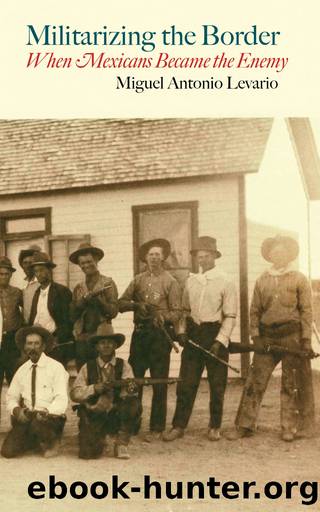Militarizing the Border by Levario Miguel Antonio;

Author:Levario, Miguel Antonio;
Language: eng
Format: epub
Publisher: Texas A&M University Press
Published: 2012-08-15T00:00:00+00:00
Conclusion
This study examined the history of West Texas and northern Mexico between 1893 and 1933 with a special focus on the establishment of US militarization and its connection to racialized social relations. West Texas as a border region provided a transnational perspective from which to analyze localized and national histories. Varying events and authority figures throughout the period demonstrate how militarization of the region as a pacifier, protector, and modernizing initiative incorporated the area into the political and cultural fabric of the United States. American authority was established during the late nineteenth century and the early twentieth century, despite challenges that included a general state of lawlessness, great distance from centers of power in Austin and Washington, DC, and the use of Mexico as a safe haven for clandestine behavior and a staging area for violent depredations into Texas. Establishing authority proved to be complicated and laden with problems, as many West Texas residents often reacted to the imposition of outside authority and order. Personal stories, policies, progressive reform, the Mexican Revolution, racial conflict, and immigration contributed to a construct of collaboration and collusion.
West Texas was a transnational commercial and political staging point throughout the period. El Paso and Ciudad Juárez experienced booming population growth and significant economic development with the introduction of the railroad and modernization. Consistent immigrant flow through El Paso and Juárez reflected and reinforced the regionâs development into a bustling port of trade and commerce between the United States and Mexico.
This study focused on the years 1893â1933 in order to measure change in the early development of the border regionâs authority structure. Military efforts to pacify the region and civic efforts to establish basic American institutions such as schools, banks, and commercial enterprises characterized the last half of the nineteenth century. Pacification followed a period of warsâthe Texas war for independence and the Mexican-American Warâand the persistence of violence that often took the form of racial and international conflict. The turn of the century and the early 1900s, on the other hand, witnessed the establishment of American rule, although conflict continued largely as a result of efforts to turn the region into an American cultural enclave.
A review of the events at the turn of the twentieth century underscores how important the state, regional, and local authorities were in the incorporation of the region into the American social economy. The process of pacifying the area and building key American institutions continued on into the early 1900s partly because of the difficulties involved in establishing authority over the great distance separating the region from centers of power. Unresolved issues of local and international natures and the persistent problem of racial tension that militarization reinforced also contributed to the slow process of establishing US authority in the region.
The period from 1893 to 1933 saw the transformation of the border region. Along with the economic and commercial changes caused by modernization, social and political shifts served as a backdrop to the story of authority-building in West Texas. The reformist agendas that swept across the state with the election of Governor Charles A.
Download
This site does not store any files on its server. We only index and link to content provided by other sites. Please contact the content providers to delete copyright contents if any and email us, we'll remove relevant links or contents immediately.
| Americas | African Americans |
| Civil War | Colonial Period |
| Immigrants | Revolution & Founding |
| State & Local |
In Cold Blood by Truman Capote(3140)
Steve Jobs by Walter Isaacson(2766)
The Innovators: How a Group of Hackers, Geniuses, and Geeks Created the Digital Revolution by Walter Isaacson(2504)
All the President's Men by Carl Bernstein & Bob Woodward(2266)
Lonely Planet New York City by Lonely Planet(2106)
The Room Where It Happened by John Bolton;(2034)
And the Band Played On by Randy Shilts(2016)
The Murder of Marilyn Monroe by Jay Margolis(1982)
The Poisoner's Handbook by Deborah Blum(1980)
The Innovators by Walter Isaacson(1973)
Lincoln by David Herbert Donald(1873)
A Colony in a Nation by Chris Hayes(1797)
Under the Banner of Heaven: A Story of Violent Faith by Jon Krakauer(1687)
Amelia Earhart by Doris L. Rich(1587)
The Unsettlers by Mark Sundeen(1586)
Birdmen by Lawrence Goldstone(1536)
Dirt by Bill Buford(1522)
Zeitoun by Dave Eggers(1518)
Decision Points by George W. Bush(1464)
